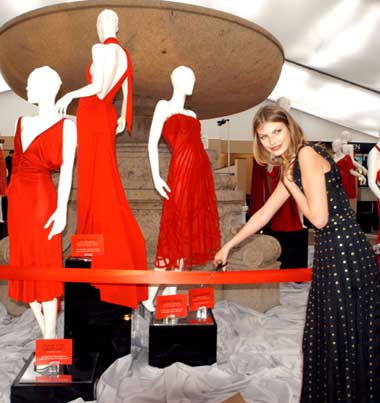 |
LEFT: At opening
day of Mercedes-Benz Fashion Week, supermodel Angela Lindvall cuts
the ribbon to unveil the Red Dress Collection and launch the red
dress as the symbol for women and heart disease. The Collection
includes 19 dresses contributed by America's hottest fashion designers,
including (pictured left to right) Diane von Furstenburg,
Vera Wang, and Nicole Miller and is part of a national campaign
sponsored by the National Heart, Lung, and Blood Institute, National
Institutes of Health, US Department
of Health and Human Services.
Participating designers
Bill Blass
Anne Klein
Badgley Mischka
Chaiken (Jeff Mahshie)
Calvin Klein
Oscar de la Renta
Diane von Furstenberg
Michael Kors
Vivienne Tam
Carolina Herrera
Ralph Lauren
Carmen Marc Valvo
Tommy Hilfiger
Luca Luca
Vera Wang
Marc Jacobs
Catherine Malandrino
Donna Karan
Nicole Miller
Additional information
NHLBI
Heart Truth
Campaign
American
Heart Association: Simple Solutions
National Women's Health Information
Center
Womenheart: the National Coalition
for Women with Heart Disease
Call 1 800 575-WELL for a
brochure on heart disease
|
|
 AST
WEEK, US Department of Health
and Human Services’ Secretary Tommy G. Thompson announced a
new national partnership with Mercedes-Benz Fashion Week and top
fashion designers to raise awareness that heart disease is the number
one killer of American women. AST
WEEK, US Department of Health
and Human Services’ Secretary Tommy G. Thompson announced a
new national partnership with Mercedes-Benz Fashion Week and top
fashion designers to raise awareness that heart disease is the number
one killer of American women.
The centrepiece of the Heart Truth campaign is
the Red Dress Project, launched in New York City by HHS'
National Heart, Lung, and Blood Institute (NHLBI),
19 participating fashion designers, Mercedes-Benz USA
and Seventh on Sixth, the producers of Mercedes-Benz New York Fashion
Week.
It is a way for the industry to give back, particularly
in an age when the public is calling for corporate responsibility.
Cardiovascular disease needs attention—it has killed more than
half a million women each year in the US
since 1984.
The Red Dress Project includes a collection of
19 red dresses from America's most prestigious designers. The dresses
symbolize the fact that heart disease is a woman's health issue
as well as a man's. The dresses will be exhibited, along with information
about women and heart disease, in Bryant Park, February 7–14,
when American designers unveil their new designs for the fall.
The Red Dress Project exhibit will also feature
a photograph by David LaChapelle of model Angela Lindvall in a dress
designed by Donna Karan. Also débuting during Mercedes-Benz
Fashion Week is a specially designed red dress pin, created by leading
accessory designer Angela Cummings and an exclusive Mercedes-Benz
Fashion Week magma red C320 Sportscoupé.
In focus group testing, the Red Dress was found
to be a memorable icon that resonated with women across the country.
And, the testing also revealed that the Red Dress and the accompanying
“heart disease doesn't care what you wear” message captures
women's attention and makes women think about their own personal
risk of heart disease.
The fashion industry's support provides a powerful
platform for NHLBI to issue this heart
health “wake-up call” to millions of women. ‘This
partnership with NHLBI is about helping
women take action to take care of their heart health. If women aren't
doing that, then it isn't going to matter what colour their dress
is,’ said Fern Mallis, executive director, Seventh on Sixth.
Heart disease risk factors include those that
are beyond women's control and those that can be changed. Those
that can't be changed are a family history of early heart disease
and age. The risk factors that can be controlled are smoking, high
blood pressure, high blood cholesterol, overweight or obesity, physical
inactivity and diabetes. While having even one risk factor is dangerous,
having multiple risk factors is especially serious, because risk
factors tend to “gang up” and worsen each other's effects.
‘The good news is that heart disease is preventable,’
notes Susan Bennett, MD, cardiologist
and medical adviser to the Heart Truth campaign. ‘Family history
can't be changed, but there are definite steps women can take to
lower their risk. Heart disease shouldn't be killing one in three
of us.’
Research shows that women are more worried about
cancer than heart disease—especially breast cancer. According
to a survey commissioned by the National Council on the Aging, only
nine per cent of women ages 45 to 64 name heart disease as the condition
they most fear, while 61 per cent name breast cancer. Yet, heart
disease, which includes coronary artery disease, congestive heart
failure, angina, and other conditions, is the leading cause of death
in American women, accounting for 366,000 deaths in 2000.
In addition to the fashion industry, NHLBI
has formed partnerships with the American Heart Association, HHS'
Office on Women's Health, Womenheart: the National Coalition for
Women with Heart Disease and other organizations committed to advancing
the women's heart health movement. •
Sourced in part from the press release.
|